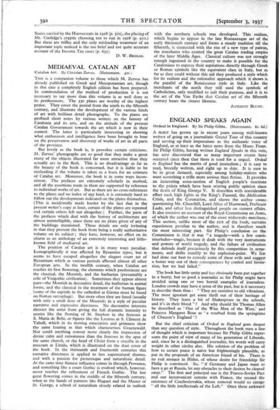MEDIAEVAL CATALAN ART
Catalan Art. By Christian Zervos. (Heinemann. 42s )
THIS is a companion volume to those which M. Zervos has already published on Greek and Mesopotamian art, though in this case a completely English edition has been prepared. In commendation of the method of production it is not necessary to say more than this volume is as well done as its predecessors. The 33o plates are worthy of the highest praise. They cover the period from the ninth to the fifteenth century, and illustrate the development of the various kinds of art with brilliant detail photographs. To the plates are prefixed short notes by various writers on the history of Catalonia and its arts, and on the attitude of the present Catalan Government towards the art which is now in their control. The latter is particularly interesting in showing what enthusiasm and intelligence have been brought to bear on the preservation and discovery of works of art in all parts of the province.
But lovely as the book is, it provokes certain criticisms. M. Zenros' photographs are so good that they make a great many of the objects illustrated far more attractive than they actually are in the flesh. This is no disadvantage as far as the beauty of the book is concerned, but it is liable to be misleading if the volume is taken as a basis for an estimate of Catalan art. Moreover, the book is in some ways incon- sistent. The prefaces are extremely scholarly in method, and all the assertions made in them are supported by reference to individual works of art. But as there are no cross-references to the plates and no index of any kind, it is extremely hard to follow out the developments indicated on the plates themselves. (This is incidentally made harder by the fact that in the present writer's copy at least, certain of the plates are repeated end certain others left out altogether.) . Further, the parts of the prefaces which deal with the history of architecture are almost unintelligible, since there are no plans given of any of the buildings mentioned. These details are only irritating in that they prevent the book from being a really authoritative volume on its subject ; they have, however, no effect on its charm as an anthology of an extremely interesting and little- known field of mediaeval art.
The position of Catalan art is in many ways peculiar. Iconographically it was affected by Byzantine types, but it seems to have escaped altogether the elegant court art of Byzantium which at various periods affected almost all other European arts. In the twelfth century, when Catalan art reaches its first flowering, the elements which predominate are the classical, the Moorish, and the barbarian (presumably a relic of Visigothic civilisation). Sometimes they appear almost pure—the Moorish in decorative detail, the barbarian in animal forms, and the classical in the treatment of the human figure (some of the capitals in the cathedral at Girona must be based on Roman sarcophagi). But more often they are fused (usually with only a small dose of the Moorish) in a style of peculiar narrative and expressive directness. No decorative interests distract the artist from giving the full dramatic intensity to stories like the Stoning of St. Stephen in The frescoes at S. Maria de Bohi, or figures like the Lazarus at S. Climent de Tahull, which in its moving emaciation and grimness show the same leaning as that which characterises Gruenewald. Nor could anything convey more clearly the impression of divine calm and remoteness than the frescoes in the apse of the same church, or the head of Christ from a crucifix in the museum at Lleida, which is illustrated on the dust cover of the book. In the thirteenth and fourteenth centuries this narrative directness is applied to less supernatural themes, and with a passion for picturesque and naturalistic detail. At the same time Sienese influence comes in through Provence, and something like a court Gothic is evolved which, however, never reaches the refinement of French Gothic. The last great flowering comes in the middle of the fifteenth century, when in the bands of painters like Huguet and the Master of St. George, a school of naturalism closely related in outlook with the northern Schools was developed. This realism, which b4ns to appear in the late Romanesque art of the early thirteenth century and forms steady tradition till the fifteenth, is connected with the rise of a new type of patron, the merchants who created the great Catalan trading empire of the later Middle Ages. Classical culture was not strongly enough ingrained in the country to make it possible for the Catalonians to express their aspirations directly through Greek or Roman symbols like the equivalent class in Italy, but as far as they could without this aid they produced a style which for its realism and the rationalist approach which it shows is the parallel of the Renaissance style in Italy. Like the merchants of the north they still used the symbols of Catholicism, only modified to suit their purpose, and it is to the art of the Van Eycks that Catalan art of the fifteenth century bears the closest likeness.
ANTHONY BLUNT.










































 Previous page
Previous page